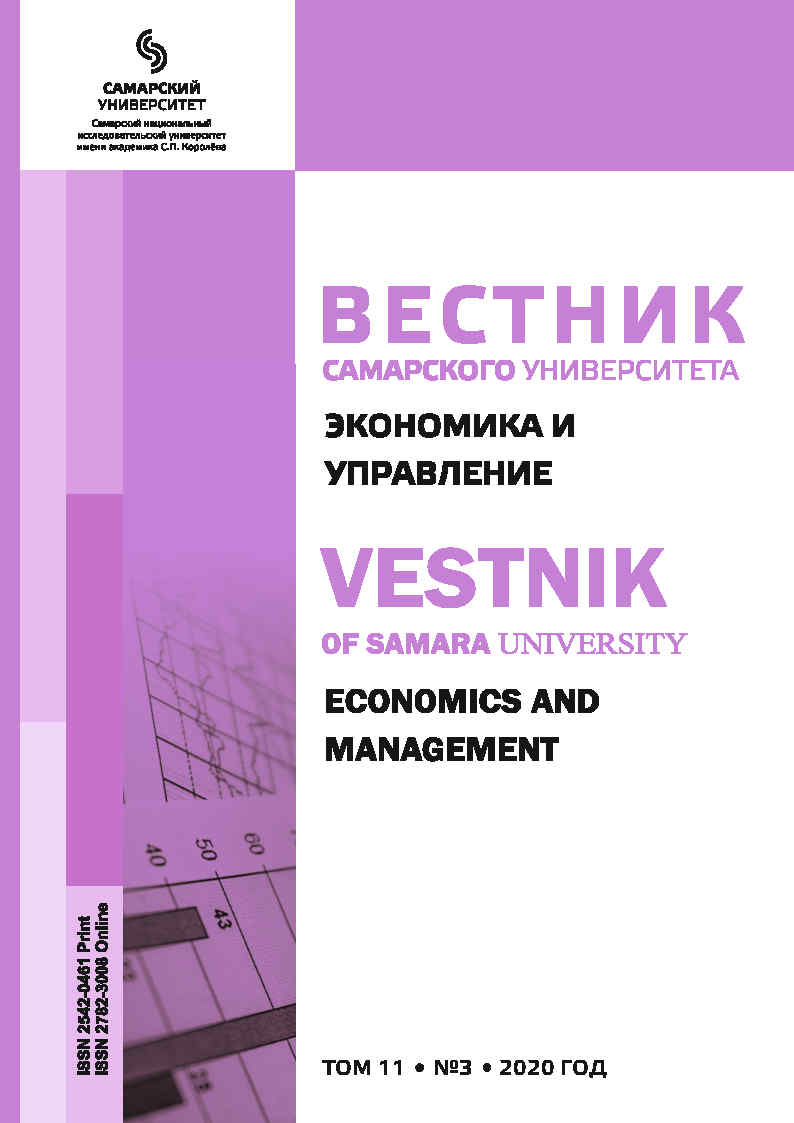ОЦЕНКА ОТРАСЛЕВОЙ СПЕЦИАЛИЗАЦИИ РАННИХ ПРЕДПРИНИМАТЕЛЕЙ: ДАННЫЕ СОВРЕМЕННЫХ СТРАН
- Авторы: Пиньковецкая Ю.С.1
-
Учреждения:
- Ульяновский государственный университет
- Выпуск: Том 11, № 3 (2020)
- Страницы: 74-81
- Раздел: ЭКОНОМИКА
- URL: https://journals.ssau.ru/eco/article/view/8139
- DOI: https://doi.org/10.18287/2542-0461-2020-11-3-74-81
- ID: 8139
Цитировать
Полный текст
Аннотация
Актуальность исследования раннего предпринимательства в современных национальных экономиках определяется возрастающей значимостью предпринимателей как в развитых, так и в развивающихся странах. Предприниматели вносят значительный вклад в экономический рост, увеличение валового внутреннего продукта, создание новых рабочих мест, а также сокращение бедности и социальной изоляции. Поэтому одной из главных задач органов государственного управления являются разработка и реализация мероприятий, обеспечивающих эффективную отраслевую политику в области развития предпринимательства. Целью исследования стала оценка сложившегося уровня специализации ранних предпринимателей в современных национальных экономиках. В процессе исследования решались следующие задачи: определение основных секторов, в которых создают свой бизнес предприниматели; формирование массивов эмпирических данных, описывающих удельные веса предпринимателей, специализирующихся на производстве товаров и оказании услуг в общей численности ранних предпринимателей по странам; разработка экономико-математических моделей, характеризующих два основных сектора специализации ранних предпринимателей. Источником информации для оценки отраслевой специализации начинающих предпринимателей послужили данные, приведенные в проекте Глобального мониторинга предпринимательства, по результатам опроса более чем 2000 ранних предпринимателей в каждой из 50 стран. В процессе экономико-математического моделирования авторы разработали функции плотности нормального распределения. Результатом вычислительного эксперимента являлась оценка значений показателей, характеризующих вовлеченность ранних предпринимателей в производственный и сервисный секторы национальных экономик. В результате проведенного исследования установлены средние значения и диапазоны изменения показателей отраслевой специализации, определены страны с высокими и низкими значениями показателей; проведен сравнительный анализ значений показателей по России и зарубежным странам; подтверждены три выдвинутые в процессе исследования гипотезы. Полученные результаты исследования обладают существенной новизной и оригинальностью, они имеют определенное теоретическое и прикладное значение. Предложенные показатели и модели их расчета могут быть использованы при обосновании программ развития предпринимательства правительством, региональными и муниципальными органами власти. Итоги расчетов представляют интерес для предпринимателей, в том числе начинающих.
Об авторах
Юлия Семеновна Пиньковецкая
Ульяновский государственный университет
Автор, ответственный за переписку.
Email: judy54@yandex.ru
кандидат экономических наук, доцент кафедры экономического анализа и государственного управления
РоссияСписок литературы
- Acs Z.J., Estrin S., Mickiewicz T.M., Szerb L. Entrepreneurship, institutional economics, and economic growth: an ecosystem perspective // Small Business Economics. 2018. Vol. 51. P. 501–514. DOI: http://doi.org/10.1007/S11187-018-0013-9.
- Janković G., Golubović M. Open innovation in small and medium-sized enterprises // Business. 2019. Vol. 65 (3). P. 89–101. DOI: http://doi.org/10.5937/ekonomika1903089j.
- Rotar L.J., Pamic R.K., Bojnec S. Contributions of small and medium enterprises to employment in the European Union countries // Economic Research-Ekonomska Istraživanja. 2019. Vol. 32: 1. P. 3302–3314. DOI: http://doi.org/10.1080/1331677X.2019.1658532.
- Kraemer-Eis H., Botsari A., Lang F., Torfs W., Gvetadze S. European Small Business Finance Outlook // EIF Working Paper 2018/53. EIF Research & Market Analysis. December, 2018. 134 p. URL: https://www.eif.org/news_centre/publications/EIF_Working_Paper_2018_53.htm.
- Asia SME Finance Monitor 2014. Asian Development Bank. Manila, 2015. 304 p. URL: https://ru.scribd.com/document/324278065/Asia-SME-Finance-Monitor-2014-pdf.
- Narteh B. SME bank selection and patronage behaviour in the Ghanaian banking industry // Management Research Review. 2013. Vol. 36 (11). P. 1061–1080. DOI: http://doi.org/10.1108/MRR-06-2012-0147.
- Simon-Moya V., Revuelto-Taboada L., Ribeiro-Soriano D. Influence of economic crisis on new SME survival: reality or fiction? // Entrepreneurship and Regional Development. 2016. Vol. 28. No. 1–2. P. 157–176. DOI: http://doi.org/10.1080/08985626.2015.1118560.
- Study on the relation between industry and services in terms of productivity and value creation. Study for the Directorate-General for Enterprise and Industry. Vienna: European Competitiveness and Sustainable Industrial Policy Consortium, ECSIP, 2014. 118 p.
- Lovelock C.H., Wirtz J. Services marketing: people, technology, strategy. Boston: Pearson, 2011. 625 p. URL: https://b-ok.cc/book/3559592/bd3641.
- Gallouj F., Weber K.M., Stare M., Rubalcaba L. The futures of the service economy in Europe: A foresight analysis // Technological Forecasting and Social Change. 2015. Vol. 94. P. 80–96. DOI: http://doi.org/10.1016/j.techfore.2014.06.009.
- Eichengreen B., Gupta P. The two waves of service sector growth // Oxford Economic Papers. 2013. Vol. 65 (1). P. 96–123. DOI: http://doi.org/10.1093/OEP/GPR059.
- Lee J.-W., McKibbin W.J. Service sector productivity and economic growth in Asia // Economic Modelling. 2018. Vol. 74 (2). P. 47–63. DOI: http://doi.org/10.1016/J.ECONMOD.2018.05.018.
- Buera F., Kaboski J. The Rise of the Service Economy // American Economic Review. 2012. Vol. 102 (6). P. 2540–2569. DOI: http://doi.org/10.1257/AER.102.6.2540.
- Oliva R., Kallenberg R. Managing the transition from products to services // International Journal of Service Industry Management. 2003. Vol. 14 (2). P. 160–172. DOI: http://doi.org/10.1108/09564230310474138.
- Clark C. The Conditions of Economic Progress. London: Macmillan. 1940. 504 p. URL: https://archive.org/details/in.ernet.dli.2015.223779.
- Fourastie J. Le Grand Espoir du XXe siècle. Progrès technique, progrès économique, progrès social. Paris: Presses universitaires de France, 1949. 224 p.
- Bell D. The Coming of Post-Industrial Society: A Venture in Social Forecasting. New York: Basic Books. 1999. 507 p.
- Fuchs V. The Service Economy. New York, 1968. 267 p.
- Global Entrepreneurship Monitor 2019–2020. Global Entrepreneurship Research Association (GERA). London: London Business School, 2020. 232 p. URL: https://www.gemconsortium.org/latest-global-reports.
- Pinkovetskaia I., Slepova V. Estimation of Fixed Capital Investment in SMEs: the Existing Differentiation in the Russian Federation // Business Systems Research. 2018. Vol. 9 (1). P. 65–78. DOI: http://doi.org/10.2478/bsrj-2018-0006.
Дополнительные файлы









